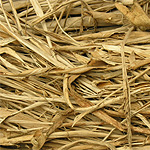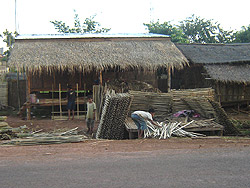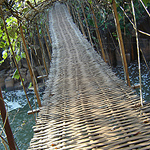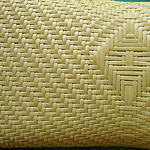“People who live in houses built on piles eat sticky rice, and listen to the music of the khene (a bamboo instrument) are surely Lao.” – A Lao saying
Illustrating how well integrated, cane and bamboo, are into every aspect of the life of a Lao. Like all countries, in the South East Asian region, the use of cane and bamboo is extensive – both as a food plant and material for a variety of objects, ranging from the knife that cuts the umbilical cord, to small traps and tools, mats and baskets, to making musical instruments, to various means of transportation and construction of houses and small buildings.
PRACTITIONERS
All ethnic minority groups are skilled at weaving a variety of baskets, and at producing household items from bamboo and wood.
A craft that for generations has been passed on, from father to son, is changing character in its organisation today. Craft workers were traditionally the elders in the family or the women. They made items such as handicrafts, mats, baskets, chopsticks and toothpicks. This was an important source of seasonal supplementary income. Traditional bamboo skills are slowly disappearing among ethnic minority groups in Laos, especially the younger generation. Practitioners are now employed by local cottage industries – men to make furniture, and women to make baskets, hats, ropes and mats.

Champassak Province
This province is famous for its fish Baskets and giant Fish Trap.
Khammouane Province
Unique crafts are made from bamboo and natural materials in Ban Phalem village including bamboo mouse traps. The two villages, Ban Natan and Ban Kong Lor produce handmade cotton weavings and bamboo crafts and handmade incense is made in Nakhangxang Village from bamboo sticks.
MATERIALS
Bamboo is a giant perennial grass found in the tropical and subtropical regions of the world. The plant can grow in both dry and cold climates. The variety or species of bamboo found differs according to the prevailing physical conditions – mountains, lowland areas, near rivers or on cultivated soil. While some species of bamboo grow to just a few cm high others reach amazing heights. The Lao people recognize two kinds of bamboo – one whose stem is used whole and the other a female bamboo, which is split and flattened and then woven. A male bamboo must be 4 years old before being cut, while a female bamboo can be harvested after 2 years.
Cane or Rattan grows primarily in the central part of Laos. Cane is a trailing or climbing kind of palm with long slender stems. It can grow up to over 200 meters in length and requires abundant water. The growth is slow for the first few years: cane can often take 15 years to come into full bearing and thereafter be harvested every two to three years. The surface of cane is covered by spiny leaves, which hide a hard, smooth and shiny exterior. The outside colour varies from shades of yellow to brown while the inside has tough, coarse fibres. More than 50 species of cane have been identified in Laos.
 |
 |

PROCESSES
Bamboo can be used untreated or treated depending on the use it is put to. The age, size, colour, moisture content and straightness of bamboo culm all contribute to the quality and durability of the product and the final pricing. Most of the processing is done by hand, with only very rudimentary tools. By and large the quality of raw materials is low and it is consumed domestically.
Cane is usually harvested by small farmers. The men harvest the cane from the forest, while women and children scrape, dry and sort the raw material. Simple labour intensive techniques and basic hand tools are used. Cane goes through several steps of processing before usage – Splitting, sizing, boiling, fumigation, washing in water, sun drying, rubbing, classifying, banding and storing. Typically, the farmers gather the material and scrape and dry it, before sending it to the towns for further processing.
 |
 |

PRODUCTS
Both cane and bamboo have been exploited for their properties of toughness, strength, and flexibility. The variety of uses, this versatile material has been put to, are too many to enumerate. Bamboo is found in every sphere of rural life being used from the manufacture of tools, providing handles for machetes, knives, saws, acting as torches for use at night, to making boats, rafts, floats, fishing nets and hunting traps. Cane and Bamboo are the materials for everyday items from furniture to kitchen equipment including mats, baskets, containers, winnowing baskets, trays, boxes, cases, sticks, tubes for carrying water or cooking rice, low tables, stools, partitions and so on. Lao houses, street stalls, animal shelters, enclosures, chicken runs, cages, granaries, hedges, fences and gates are made entirely of bamboo. Cane has a lustre that is reflected in the finished goods. Small-sized cane is used for making baskets, thatching, matting, etc. while large-diameter cane is mostly used for the production of furniture.
Bamboo is use to produce three types of musical instruments: percussion or hammer instruments, wind instruments, and stringed instruments. The bamboo khene, is a unique Lao instrument – a small piped instrument, khene is made from a special kind of bamboo, similar to reed – the length and size and the number of pipes depending on the type of sound required.
Basket weaving is practiced widely by ethnic minority groups from all the three major language families and includes the production of fish and animal traps, mats and all kinds of household containers, including the familiar back-basket. There is a tremendous variety in the shape, size of baskets and the use each is put to. Among the best baskets and mats are those woven by the Lao Thoeng.
 |

CURRENT STATUS
With the introduction of materials, like plastics, especially in the towns and cities, the traditional use of bamboo for everyday objects is declining. Houses made of bamboo are being replaced by brick and concrete structures. One reason for this fall in demand is the fragility of the material – cane and bamboo need to be constantly renewed and have a short life span, in the tropical Lao climate, when compared with other available materials.
Gallery
YOUR VIEWS
PRACTITIONERS: INDIA
Access 70,000+ practitioners in 2500+ crafts across India.
BIBLIOGRAPHY
10,000+ listings on arts, crafts, design, heritage, culture etc.
GLOSSARY
Rich and often unfamiliar vocabulary of crafts and textiles.
SHOP at India InCH
Needs to be written.






